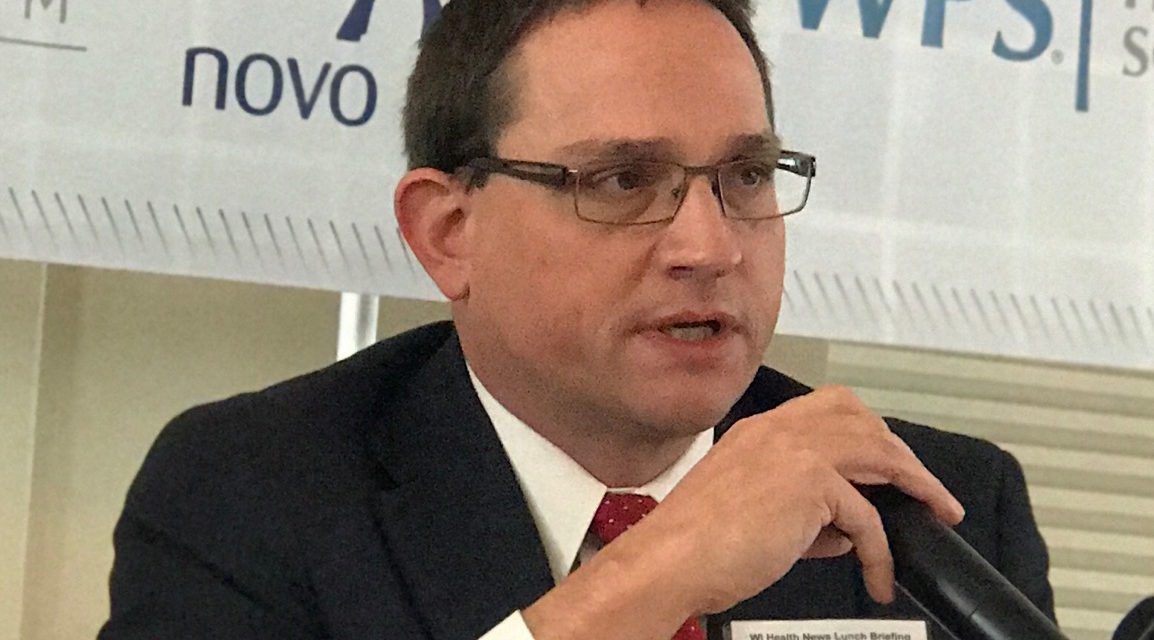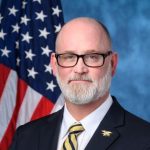
WHA CEO Borgerding talks legislative priorities

As the state continues digging out from the COVID-19 pandemic, the biggest legislative priority for Wisconsin hospitals is continuing a reimbursement increase for providers that take on a larger share of low-income patients.
The current budget allocates $40 million for the disproportionate share hospital program. Combined with federal matching dollars, that’s meant $100 million over two years for hospitals in the program.
The Wisconsin Hospital Association hopes to keep that going in the next spending plan, and possibly make it permanent.
“Obviously, there’ll be half a dozen or more other things in the budget that we will be engaged on to some degree or another, but we really try to be very judicious in our prioritization and DSH is certainly our top priority,” WHA CEO Eric Borgerding said during a recent interview with Wisconsin Health News.
Borgerding also discussed Medicaid expansion, telehealth and emergency detention.
Edited excerpts are below.
WHN: What are hospitals’ legislative priorities this session?
EB: First and foremost is the state budget. And first and foremost for us within the state budget is making sure that we don’t see a cut to hospital Medicaid reimbursement. It’s kind of hard to fathom that as we’re coming out of COVID that there would actually be a reduction in reimbursement. We’re very focused on reauthorizing the increase in the disproportionate share hospital program that was put into the current state budget, and just making sure that that continues forward in this budget and, hopefully, ongoing. That’s about a $40 million (general purpose revenue) item. And combined with the federal match that draws down a total of about $100 million over the biennium, it’s the same level of funding that’s in the current state budget. It’s not an actual increase in the DSH program per se. Rather, it’s focusing on avoiding a cut of about $100 million all funds if it’s not restored.
WHN: Outside the budget, what issues are you focused on?
EB: A lot of it will be COVID-learned or COVID-driven. I think that the opportunity that COVID has presented – it’s an opportunity that we wish we never had – but I think it’s certainly underscored some existing challenges in the healthcare system. And I think expedited, and in a lot of ways proven, some regulatory reforms and changes that were granted. So a couple examples, the inability to discharge patients out of a hospital back to a skilled nursing facility or some other sort of post-acute care facility, the difficulties in doing that have been a problem for some time, and were greatly exacerbated during COVID.
Particularly in the fall, we needed every inpatient bed that we could possibly get. So when you have patients that really are ready to be discharged to a different setting, a better setting for them in their care, and they can’t, that causes a number of problems. So, we’ve got to get serious about this. And, so that will be a priority, whether part of the state budget or something else. It’s a multifaceted challenge, and it’s going to take a lot of collaboration and groups being at the table. But, I think there’s probably more understanding of this problem than there ever has been. And so we’re intent on pushing some things forward.
Other issues, a lot of it is implementation. For example, AB 148, implementing some of the really significant licensure reforms that were included in that legislation. I think what was done on licensure is probably one of the biggest things we’ve done in the healthcare workforce and licensure space in many years.
WHN: What are some of the licensure changes that are part of that?
WB: Allowing a provider who is licensed in good standing in another state to essentially be licensed right away in Wisconsin, if they can attest to and prove that they’re licensed in good standing in another state and they’re beginning the permanent Wisconsin licensure process.
We have a number of members every year who have either needed to bring other providers in or make them accessible in Wisconsin, either physically or through telehealth, to address a surge in demand like during a pandemic – again, an issue underscored by COVID. Or they have spent months recruiting a specialist. For example, a psychiatrist or a urologist or a general surgeon. They’ve spent months recruiting someone to their hospital and their community, only to have to wait three, four, five, six months for that person to be licensed here and be able to practice. So I think that is a significant change born out of COVID but now permanent in Wisconsin. We have to work on making sure something like that is implemented.
WHN: Hospitals have been involved in efforts to reform the emergency detention process. What is the latest with that?
EB: Emergency detention is a serious problem in Wisconsin. And it probably has the most attention and the most collaboration to date around trying to find incremental as well as large-scale, systematic reforms. You’ve got local governments willingly at the table. You’ve got law enforcement willingly at the table. You’ve got some of the advocate groups at the table and, of course, WHA as the providers at the table. And then a lot of bipartisan interest in addressing our emergency detention system. So, that’s a great example of an issue that doesn’t lend itself to a quick solution, because there’s a lot of aspects and facets to the problem. But, I’m encouraged by the bipartisan and multi-organization commitment to crafting some solutions going forward.
WHN: One of the governor’s biggest priorities is the expansion of Medicaid under the Affordable Care Act, which the nonpartisan Legislative Fiscal Bureau estimates could bring in an additional $1.6 billion to the state over the next two years. Is this something that hospitals support? Why or why not?
EB: Here’s the thing with Medicaid expansion, it’s obviously an important and valid public policy discussion and debate. I think that Wisconsin, for better or for worse, depending on your perspective, Wisconsin continues to be an asterisk in the white papers and analyses of expansion. And this temporary bonus arguably increases the stakes and the considerations around Medicaid expansion.
Now, having said that, I think there remain both policy and political realities that right now I just don’t see changing. The governor’s making a strong case for it, but on the other hand, you have pretty strong opposition still in the Legislature. And some of that is based on a lack of trust of the federal government. But a lot more sort of philosophical opposition.
We try not to get wrapped up in the ‘yes’ or ‘no,’ and instead focus on what can we achieve in Wisconsin. For example, we have 80,000 people in the state right now that are eligible for Medicaid and they are not enrolled. Why not? We’re very pleased to be literally at the table with (Department of Health Services) and (The Office of the Commissioner of Insurance) and their healthcare coverage partnership …. We have almost as many people who are eligible for Medicaid right now who are unenrolled as would be added to Medicaid under expansion. So, that’s not an argument against expansion. It’s really a point that, look, we’ve got a lot of coverage expansion we can work to achieve now, whether or not the state adopts Medicaid expansion.
WHN: Expanding Medicaid would do more than just cover more people, it would bring in a substantial amount of new federal funding into the state. Isn’t that something hospitals should be strongly advocating for?
EB: Well, like I said, I don’t think it’s gonna happen. Speaker (Robin) Vos, (R-Rochester), other leaders in the Legislature, have pretty much drawn that line in the sand. Regardless of whether you’re pro-expansion, or against expansion, that seems to be an ongoing reality. It is what it is. And so, WHA really, again, focuses on what can we do within the political and policy environment that exists. What can we do to achieve the best outcome – both in terms of investments in healthcare, with or without expansion. And what can we do to improve investment in healthcare and sustain and grow coverage. That’s what we focus on doing.
WHN: Hospitals have relied more and more on telehealth over the past year. What more can policymakers do to support telehealth in the state?
EB: We could probably have an FTE, maybe 1.5 full time at WHA just to work on telehealth. The plate of issues that are either directly or indirectly affected by telehealth is pretty substantial. Everything from infrastructure, like broadband, to workforce, licensure payment, reimbursements. It’s just a very rich environment for public policy.
COVID has taught us a couple things that we want to learn from. Number one, that the public’s comfort with telehealth is still second to in-person care, but it has certainly continued to grow. The satisfaction with and the outcomes and comfort with a virtual visit or monitoring at home, those kinds of things have improved across the board. Especially in behavioral health, an area where we have the greatest and most urgent needs as it relates to access. There’s very high patient satisfaction with behavioral telehealth, significantly easier access for this population, big reductions in no shows and high demand. So, what can we do to make sure that that continues? Because when you have people seeking and receiving that kind of care, it has downstream impacts. Behavioral health and mental health is tied directly to physical health and vice versa.
So, there’s a lot of things we have to be looking at. Licensure, for example. We want to make sure that as we look ahead to licensure, is telehealth really any different? From a licensure perspective, is delivering care through telehealth any different than delivering that care in person? We, by and large, think the answer to that is no, there isn’t any difference. And so we want to make sure that as we start to update licensure for specialties or other types of providers that we’re keeping that in mind.
WHN: Are you advocating for any changes to insurance coverage of telehealth?
EB: Parity is a complex question. We have a telehealth workgroup that’s existed for almost four years, and has really been driving a lot of WHA’s telehealth agenda.
So, we’re digging now very heavily into the weeds on this issue of reimbursement parity. What does it mean in Wisconsin, compared to other states? What’s different about Wisconsin that would lend more urgency to ‘parity’? I think we have to make sure we understand what it is, and then craft policy that makes sense for Wisconsin.
This article first appeared in the Wisconsin Health News daily email newsletter. Sign up for your free trial here.





